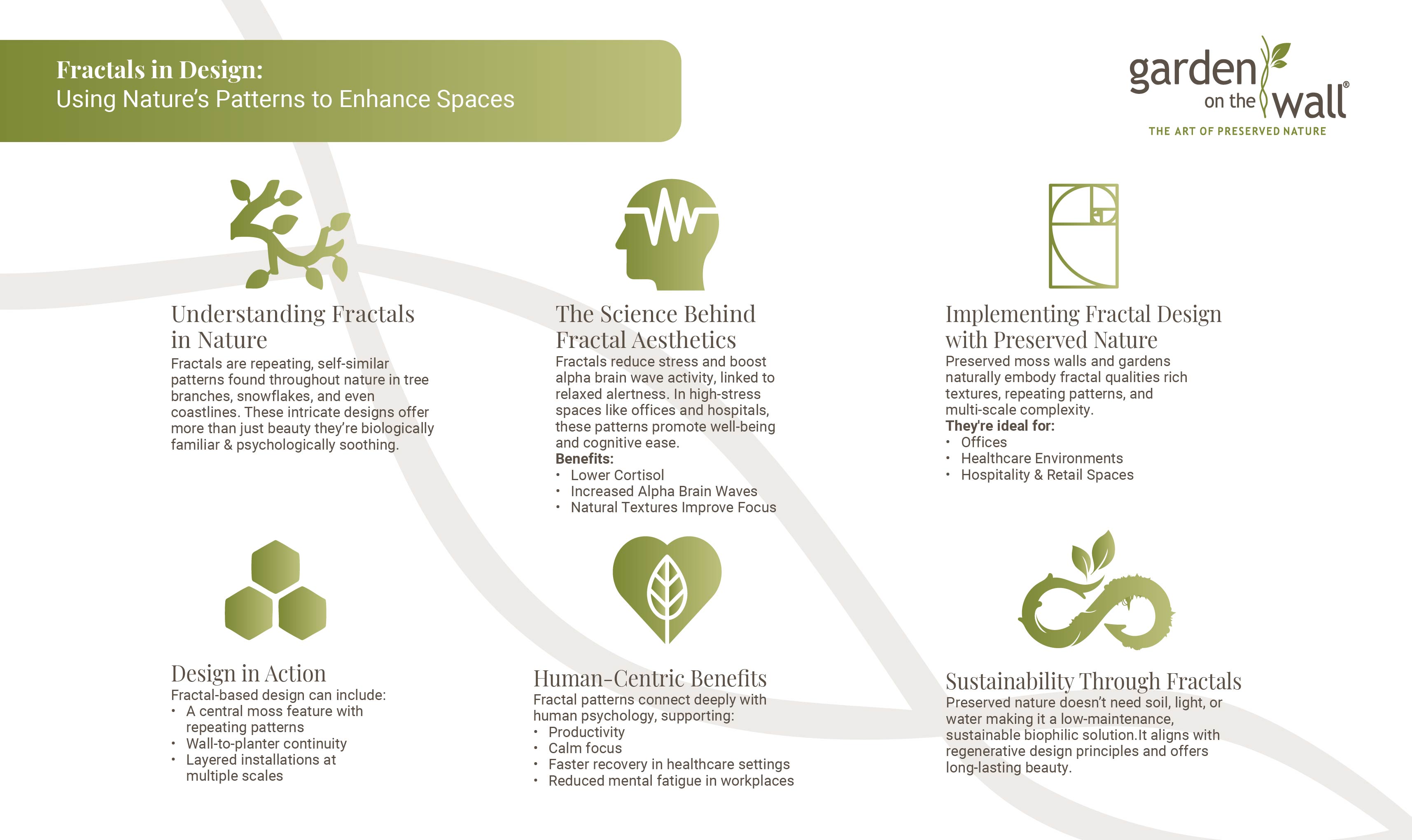Garden on the Wall®
Fractals in Design: Using Nature's Patterns to Enhance Spaces

Understanding Fractals in Nature
Fractals, the intricate patterns that repeat at different scales, are ubiquitous in nature. From the branching of trees to the structure of snowflakes, these self-similar patterns are fundamental to the natural world. In recent years, designers and architects have recognized the power of fractals to create visually appealing and psychologically beneficial spaces.
The incorporation of fractal patterns in design, particularly through the use of preserved gardens and moss walls, offers a unique opportunity to bring nature's intricate beauty into built environments. These biophilic elements not only add aesthetic value but also contribute to occupant well-being by mimicking the patterns our brains are evolutionarily primed to appreciate.
The Science Behind Fractal Aesthetics
Research in neuroaesthetics has shown that exposure to fractal patterns can reduce stress levels and increase alpha brain wave activity, associated with wakeful relaxation. This scientific backing underscores the importance of incorporating fractals into design, particularly in high-stress environments such as offices, healthcare facilities, and urban spaces.
Preserved moss walls and gardens are ideal mediums for introducing fractal patterns into interior design. The natural variations in moss textures and the arrangement of preserved plants can create complex, multi-scale patterns that resonate with our innate appreciation for natural forms. This alignment with nature's geometry contributes to the creation of more harmonious and psychologically supportive spaces.
Implementing Fractal Design with Preserved Nature
Designers can leverage the inherent fractal qualities of preserved moss and plants to create visually striking and biophilic-rich environments. By carefully arranging preserved elements at various scales, from large moss walls to smaller planter inserts, designers can create a sense of depth and complexity that draws the eye and engages the mind.
The versatility of preserved nature allows for creative implementations of fractal design. For instance, a large-scale preserved garden could feature a central pattern that repeats in smaller elements throughout the space, creating a cohesive and visually intriguing environment. This approach not only enhances the aesthetic appeal of a space but also reinforces wayfinding and spatial recognition.

Fractals and Human-Centric Design
The integration of fractal patterns through preserved nature aligns closely with the principles of human-centric design. By creating environments that resonate with our innate preferences, designers can craft spaces that support cognitive function, reduce mental fatigue, and enhance overall well-being.
In workplaces, fractal-rich preserved moss walls can serve as both aesthetic focal points and functional elements that improve employee satisfaction and productivity. In healthcare settings, these natural patterns can contribute to creating calming environments that support patient recovery and staff performance. The application of fractal design principles through preserved nature thus becomes a powerful tool in creating spaces that truly cater to human needs.
Balancing Complexity and Order
One of the key challenges in implementing fractal design is striking the right balance between complexity and order. While fractals are inherently complex, too much intricacy can lead to visual overwhelm. Designers must carefully consider the scale and repetition of patterns to create spaces that are stimulating yet soothing.
Preserved gardens and moss walls offer an advantage in this regard, as their natural variations provide a built-in balance of complexity and order. By thoughtfully composing these elements, designers can create environments that are visually rich without being chaotic, fostering a sense of calm and engagement among occupants.
Fractals in Sustainable and Regenerative Design
The use of fractal patterns in design, particularly through preserved nature elements, aligns well with principles of sustainable and regenerative design. Unlike living plants that require ongoing resources, preserved moss and plants maintain their fractal beauty with minimal maintenance, contributing to more sustainable interior environments.
Moreover, the longevity of preserved nature installations ensures that the biophilic benefits of fractal patterns persist over time. This durability makes them an excellent choice for creating lasting, nature-inspired environments that support both human well-being and environmental sustainability.
The Future of Fractal Design in Architecture
As our understanding of the psychological and physiological benefits of fractal patterns grows, we can expect to see more innovative applications in architecture and interior design. The integration of technology with preserved nature elements may lead to dynamic fractal displays that adapt to occupant needs or environmental conditions.
The future of fractal design also holds promise for creating more resilient and adaptive spaces. By mimicking nature's efficient and resilient patterns, architects and designers can create buildings and interiors that are not only visually appealing but also more capable of responding to changing environmental and human needs. As we continue to explore the potential of biophilic design, fractals will undoubtedly play a crucial role in shaping the spaces of tomorrow.
For more information on this subject and other related information, please visit our website: www.gardenonthewall.com
Related Posts

The Intersection of Mindful Design and Workplace Wellness

Designing for Client, and Designing for Climate


